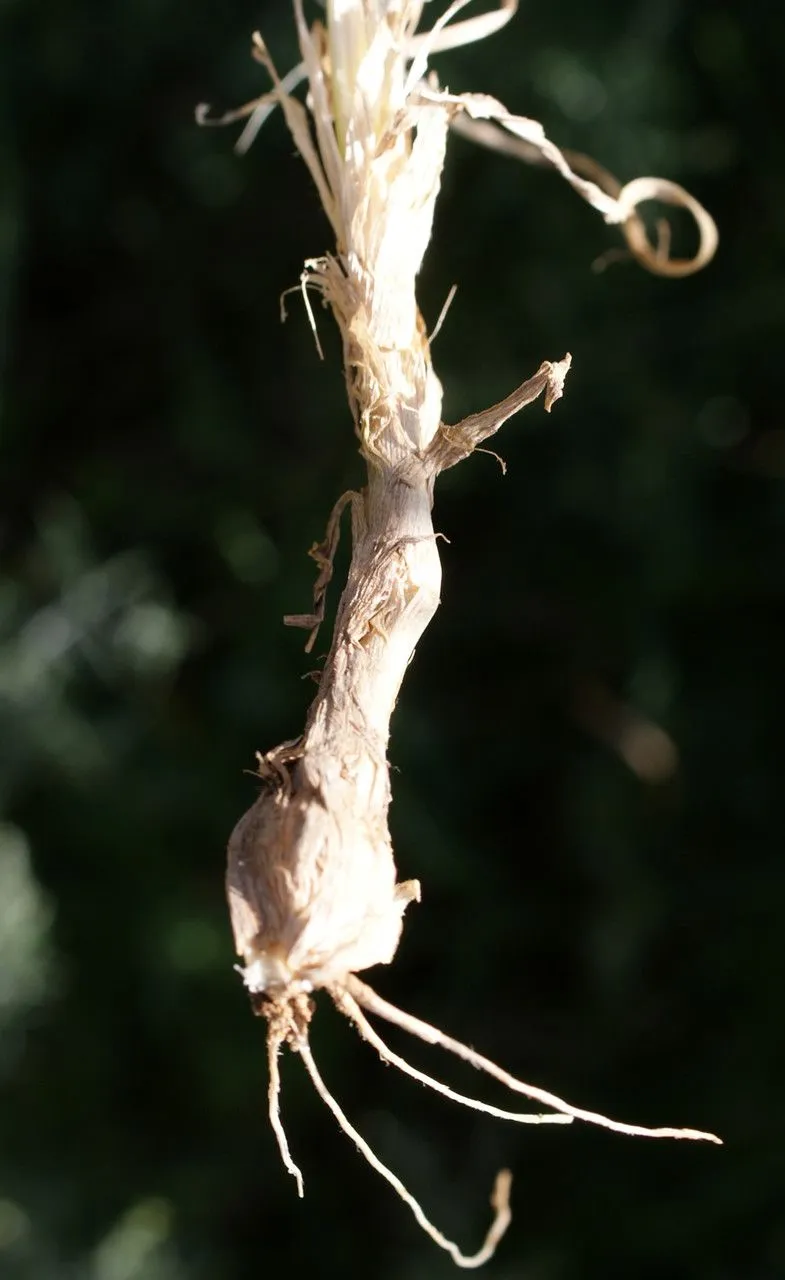
Author: L.
Bibliography: Cent. Pl. II: 8 (1756)
Year: 1756
Status: accepted
Rank: species
Genus: Hordeum
Vegetable: Unknown
Observations: Medit. to W. & C. Asia
Bulbous barley, known scientifically as Hordeum bulbosum, is a significant species within the Poaceae family. First described by the renowned botanist Carl Linnaeus in 1756, this perennial grass is native to the Mediterranean region extending into Western and Central Asia.
Characterized by its distinctive bulbous base, Hordeum bulbosum thrives in arid to semi-arid climates, adapting well to a variety of soil types which makes it a versatile species in its native range. This adaptability has allowed it to persist in a range of habitats from coastal regions to inland areas with varying degrees of moisture availability.
The leaves of Bulbous barley are typically flat and linear, resembling those of other barley species, but it’s the presence of the bulbous structures at the base of the stems that truly sets this species apart. These bulbs serve as storage organs, enabling the plant to survive periods of drought by storing water and nutrients.
The flowering phase of Hordeum bulbosum is marked by the emergence of distinctive inflorescences known as spikelets, which contain the reproductive organs of the plant. These spikelets are typically arranged in a characteristic barley-like structure, facilitating efficient pollination and seed dispersal.
Ecologically, Bulbous barley plays a crucial role in its native habitats. It provides food resources for a variety of wildlife, including insects and small mammals, while also contributing to the stabilization of soil in areas prone to erosion. Moreover, its ability to endure harsh conditions makes it an important species for studying plant resilience and adaptation to climate change.
In addition to its ecological importance, Hordeum bulbosum has been studied for its potential agricultural benefits. Its hardiness and adaptability make it a candidate for breeding programs aimed at improving crop resilience and yield in the face of increasing environmental stresses.
In summary, Bulbous barley, or Hordeum bulbosum, represents a fascinating blend of botanical resilience and ecological significance. Its adaptation to diverse environments and potential applications in agriculture highlight its importance within both natural and human-modified landscapes.
Eng: bulbous barley
Dan: knold-byg
Deu: knollengerste
Fra: orge, orge bulbeuse
Hun: gumós árpa
Swe: knylkorn
Ara: شعير بصلي
En: Bulbous barley
Ar: شعير بصيلي, شعير بصلي
Bg: Луковичен ечемик
Zh: 球茎大麦
Da: Knold-byg
Fi: Mukulaohra
Fr: Orge bulbeuse, Orge
De: Knollengerste, Nacktgerste
He: שעורת הבולבוסין
Hu: Gumós árpa
It: Orzo bulboso
Kk: Тауарпа
Ru: Ячмень луковичный
Sv: Knylkorn
Uz: Taktak
Taken May 1, 2014 by Tela Botanica − Liliane Roubaudi (cc-by-sa)
Taken May 1, 2014 by Tela Botanica − Liliane Roubaudi (cc-by-sa)
Taken May 1, 2022 by Fabrizio Foschi (cc-by-sa)
Taken Jun 11, 2011 by Pedro Gaspar (cc-by-sa)
Taken Jun 11, 2011 by Pedro Gaspar (cc-by-sa)
Taken May 22, 2010 by Tela Botanica − Christophe GIROD (cc-by-sa)
Taken Nov 16, 2009 by Tela Botanica − Christophe GIROD (cc-by-sa)
Taken Nov 16, 2009 by Tela Botanica − Christophe GIROD (cc-by-sa)
Taken May 15, 2019 by Anne-Marie Brunel (cc-by-sa)
Taken Jun 25, 2014 by Tela Botanica − Yoan MARTIN (cc-by-sa)
Taken May 10, 2020 by Inna2208 Inna2208 (cc-by-sa)
Taken Aug 29, 2019 by Vicky Stabouly (cc-by-sa)
Taken Jun 2, 2018 by Philip Filtsos (cc-by-sa)
Taken Apr 28, 2013 by Tela Botanica − Geneviève Botti (cc-by-sa)
Taken May 22, 2021 by Castillo Iglesias (cc-by-sa)
© copyright of the Board of Trustees of the Royal Botanic Gardens, Kew.
© copyright of the Board of Trustees of the Royal Botanic Gardens, Kew.
© copyright of the Board of Trustees of the Royal Botanic Gardens, Kew.
Taken May 15, 2016 by Photoflora – Benoit BOCK (©)
Taken May 15, 2016 by Photoflora – Benoit BOCK (©)
Taken Apr 28, 2013 by Tela Botanica − Liliane Roubaudi (cc-by-sa)
Taken Jan 1, 1970 by Photoflora – L’Abbé COSTE (©)
Taken May 15, 2016 by Photoflora – Benoit BOCK (©)
Taken Apr 15, 2016 by Photoflora – Jean-Luc TASSET (©)
Taken May 10, 2006 by Tela Botanica − Liliane Roubaudi (cc-by-sa)
Taken Jun 25, 2014 by Tela Botanica − Yoan MARTIN (cc-by-sa)
Taken May 1, 2014 by Tela Botanica − Liliane Roubaudi (cc-by-sa)
Taken May 1, 2014 by Tela Botanica − Liliane Roubaudi (cc-by-sa)
Taken May 1, 2014 by Tela Botanica − Liliane Roubaudi (cc-by-sa)
Family: Myrtaceae Author: (F.Muell.) K.D.Hill & L.A.S.Johnson Bibliography: Telopea 6: 402 (1995) Year: 1995 Status:…
Family: Rubiaceae Author: Pierre ex A.Froehner Bibliography: Notizbl. Bot. Gart. Berlin-Dahlem 1: 237 (1897) Year:…
Family: Sapindaceae Author: Koidz. Bibliography: J. Coll. Sci. Imp. Univ. Tokyo 32(1): 38 (1911) Year:…
Family: Asteraceae Author: A.Gray Bibliography: Pacif. Railr. Rep.: 107 (1857) Year: 1857 Status: accepted Rank:…
Family: Fabaceae Author: Medik. Bibliography: Vorles. Churpfälz. Phys.-Ökon. Ges. 2: 398 (1787) Year: 1787 Status:…
Family: Aspleniaceae Author: (Cav.) Alston Bibliography: Bull. Misc. Inform. Kew 1932: 309 (1932) Year: 1932…